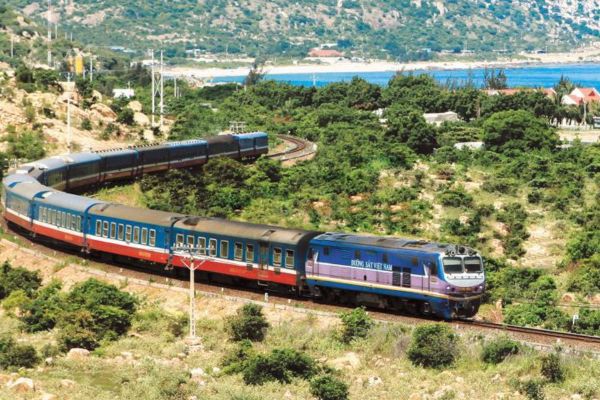What regulations must road users comply with when crossing railway level crossings? How are level crossings managed?
What regulations must road users comply with when crossing a level crossing?
Based on the regulations stipulated in Article 31 of Circular 29/2023/TT-BGTVT, road users when crossing a level crossing must comply with the laws of the road, the laws of the railway, and adhere to the following regulations:
- Must give priority to vehicles operating on the railway.
- Must obey the instructions of the level crossing staff and the signals within the level crossing area.
- When there are stop signals such as flashing red lights, red flags, red signs, horns, bells, or sound-emitting loudspeakers, when the level crossing barriers are moving or closed, under the instructions of the level crossing staff, all road users (including vehicles with priority rights) must stop on the right side of the road, before the stop line.
- Unauthorized individuals must not open the level crossing barriers when they are closed.
- For level crossings with signal signs, road users must stop before the stop line, listen for train whistles, pay attention to trains approaching from both directions, and only proceed when it is assured that no trains are approaching. They are fully responsible if an accident occurs.

What regulations must road users comply with when crossing a level crossing? How is the level crossing managed? (Image from the Internet)
How is the level crossing managed?
Based on the regulations stipulated in Article 30 of Circular 29/2023/TT-BGTVT, the management of level crossings includes the following contents:
- Establish, update, and store the management dossier of the level crossing according to the regulations in Article 29 of Circular 29/2023/TT-BGTVT; update the level crossing dossier into the management information system database.
- Inspect and maintain the operational status of the level crossing to ensure traffic safety as approved by the competent authority.
- Organize and directly implement the level crossing safeguards as stipulated in this Circular.
- Manage and protect level crossing assets and traffic safety corridors at level crossings as prescribed by law.
- For level crossings with lost construction permits or decisions on putting the level crossings into operation:
+ In the case of level crossings on the national railway: The owner of the private level crossing shall establish the current status dossier of the level crossing and submit it to the Vietnam Railway Authority for opinions on the conditions for continued operation of the level crossing;
+ In the case of public level crossings on dedicated railways related to national highways: The management and operation organization of the level crossing shall establish the current status dossier of the level crossing and submit it to the Vietnam Road Administration for opinions on the conditions for continued operation of the level crossing;
+ In the case of public level crossings on dedicated railways related to provincial, district, commune, or urban roads: The management and operation organization of the level crossing shall establish the current status dossier of the level crossing and submit it to the provincial People's Committee for opinions on the conditions for continued operation of the level crossing.
What are the regulations on the position and angle of newly constructed level crossings?
Based on the regulations in Clause 1, Article 6 of Circular 29/2023/TT-BGTVT, the position and angle of newly constructed level crossings are regulated as follows:
For newly constructed level crossings:
- The level crossing must be located on a straight section of the railway. In special difficult cases where it must be located on a curved section, it can only be placed on a circular curve with a minimum radius of 300 meters (m), and must not be placed on a transitional curve;
- The level crossing must be at least 100 meters (m) away from tunnel entrances and railway bridge abutments;
- The distance between two level crossings outside urban areas must not be less than 1000 meters (m), and not less than 500 meters (m) within urban areas, except in cases where existing roads such as provincial, district roads intersect with the railway;
- The level crossing must be located outside the station entrance signal posts; the nearest position of the level crossing must be at least 3.5 meters (m) away from the station entrance signal posts;
- The intersection angle between the railway and the road must be a right angle (90°); in difficult terrain conditions, the intersection angle must not be less than 45° and must ensure visibility as prescribed by the laws on the management and protection of railway infrastructure.
*Note: In cases where newly constructed level crossings do not meet one or more of the above conditions, when proposing the construction of the level crossing, the project investor must clarify the site conditions, financial resources, ensuring conformity with the approved planning by the competent authority, and meet the local socio-economic development needs.
For existing level crossings that do not meet the conditions stipulated in points a, b, c, d, e, Clause 1, Article 6 of Circular 29/2023/TT-BGTVT:
- During use and operation, the railway infrastructure business enterprise (for public level crossings on the national railway), the owner of dedicated railways (for public level crossings on dedicated railways), the managing and using agency of the level crossing (for private level crossings), agencies under the delegation, authorization of the provincial People's Committee, and the Vietnam Railway Authority shall implement measures to ensure traffic safety at dangerous locations as stipulated in Article 9 of Decree 65/2018/ND-CP.
- When renovating and upgrading level crossings, the project investor must adequately arrange the level crossing safeguard system and gradually improve at least one of the technical elements of the road passing through the level crossing regarding alignment, intersection angle, longitudinal profile.
Circular 29/2023/TT-BGTVT is effective from December 1, 2023.
LawNet